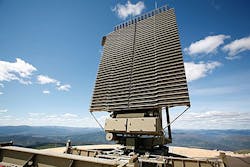Lockheed Martin to provide array electronics for TPS-59 air- and missile-search radar
TOBYHANNA, Pa., 16 June 2014.Radar experts at the Lockheed Martin Corp. Mission Systems and Training segment in Syracuse, N.Y., will provide array electronics for the AN/TPS-59A version 3 transportable long-range search radar system under term of a $35.7 million contract awarded Friday by the U.S. Army Contracting Command at Tobyhanna, Pa.
The AN/TPS-59A(V)3 is a long-range 3-D ground-based air surveillance radar. The system is for anti-air warfare to a maximum range of 300 nautical miles, and tactical ballistic missile surveillance to a range of 400 nautical miles.
The radar, the latest version of the TPS-59 fielded in 1985, can detect and track air-breathing targets like aircraft and cruise missiles as far away as 300 miles, and can detect tactical ballistic missiles as far away as 400 miles. It offers 360-degree coverage to elevations of nearly 200 miles.
For this contract Lockheed Martin will concentrate on the TPS-59 radar's array electronics. the radar's 54 transmitters are laid out in 54 rows, each of which operates independently of the others.
Related: Lockheed Martin to upgrade computers in Marine Corps TPS-59 deployable air search radar
The radar handles azimuth scanning by the antenna's mechanical rotation, while handling electronic scanning in elevation by with phase-controlled solid-state row transmitters and row receivers.
The radar uses a scanning pencil-beam to provide wide, accurate coverage. It can track targets as small as one meter wide at ranges to 400 nautical miles. It is designed to provide land forces such as the U.S. Marines with tactical air surveillance, and can contribute to the Navy Cooperate Engagement Capability (CEC).
Lockheed Martin won a $7.5 million U.S. Marine Corps contract last fall to upgrade computers for the AN/TPS-59A(V)3 radar. Lockheed Martin is upgrading the radar system's obsolete Oracle Sun Netra T5220 carrier-grade ruggedized computer servers, the operations console computers, and re-integrate the system's proprietary software.
Engineers are replacing the Oracle Sun Netra T5220 rugged server with the Oracle Sun Netra T4-1 carrier-grade server, which the Marine Corps will procure through the Marine Corps Common Hardware Suite (MCCHS) and provided to Lockheed Martin as government-furnished property.
Related: Navy chooses 6U VME single-board computers from Curtiss-Wright for shipboard radar
The Netra SPARC T4-1 server is powered by the eight-core and four-core SPARC T4 processor with integrated on-chip cryptographic support for wire-speed encryption capabilities. This server offers 16 DIMM slots, which can support 256 gigabytes of memory, four hot-pluggable 2.5-inch drives plus DVD, integrated 10 Gigabit Ethernet networking, and built-in PCI Express Generation 2 expansion.
The server runs the Oracle Solaris operating system and virtualization software such as the Oracle Solaris Zones and Oracle VM Server for SPARC technology.
For the contract announced Friday, Lockheed Martin will do the work in Syracuse, N.Y., Oldsmar, Fla., and Moorestown, N.J., and should be finished by July 2017.
For more information contact Lockheed Martin Mission Systems and Training online at www.lockheedmartin.com/us/mst, or the Army Contracting Command-Tobyhanna at www.tobyhanna.army.mil/organization/contracting.

